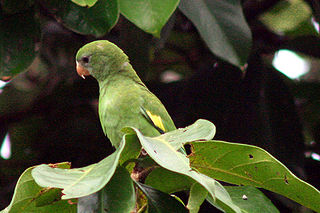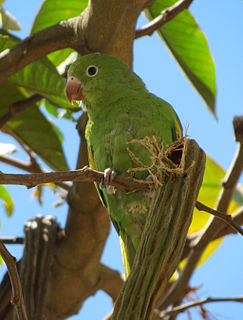 W
WBrotogeris is a genus of small parrots endemic to Central and South America. Their closest relative is the monk parakeet. They eat seeds and fruit. The word brotogeris means "having the voice of a human". In the language of their native countries, which is mostly Spanish, they are called pericos - the translation of which is "parakeet". Their average lifespan is 15 years, although some have been reported to have lived up to 35 years. Also, the bird was found in Rio Grande do Sul in South America.
 W
WThe cobalt-winged parakeet is a species of bird in the family Psittacidae, the true parrots. It is found in the eastern Andean foothills, the far western Amazonian regions in Venezuela, Colombia, Ecuador, Peru, and Bolivia; and Brazil, in the Amazon Basin states of Amazonas, Acre, and Rondonia. Its natural habitats are subtropical or tropical, moist lowland forests and heavily degraded former forest.
 W
WThe golden-winged parakeet is a species of bird in the family Psittacidae, the true parrots.
 W
WThe grey-cheeked parakeet, less commonly known as fire-winged parakeet, is a species of parrot in the family Psittacidae.
 W
WThe orange-chinned parakeet, also known as the Tovi parakeet, is a small mainly green parrot of the genus Brotogeris. It is found from Mexico, through Central America, to Venezuela. Its natural habitats are subtropical or tropical dry forests, subtropical or tropical moist lowland forests, and heavily degraded former forest. Its name comes from a small clump of bright orange feathers located under the lower beak. Like other parrots, it is capable of imitating simple human speech.
 W
WThe plain parakeet is a species of parrot in the family Psittacidae endemic to Brazil. Its natural habitats are subtropical or tropical moist lowland forest, subtropical or tropical moist montane forest, and heavily degraded former forest. It is common in the urban areas of São Paulo and Curitiba in South Brazil. The plain parakeet is notable for being plain green all over. Its beak is a pinkish colour.
 W
WThe tui parakeet is a species of bird in the family Psittacidae, the true parrots. It is found in the Amazon Basin of Brazil, and Amazonian Peru and Bolivia; also a minor range into eastern Ecuador, and the river border of far south-eastern Colombia.
 W
WThe white-winged parakeet, or canary-winged parakeet is a small parrot native to the Amazon River basin from southeast Colombia to the river's mouth in Brazil. Caged birds have been released and the birds have established self-sustaining populations in Lima, Peru, Los Angeles and San Francisco, California, and Miami, Florida areas of the United States, and in Puerto Rico. Although feral birds are showing some recent declines as nesters in the United States, they seem to be doing well in their native habitat.
 W
WThe yellow-chevroned parakeet is native to tropical South America south of the Amazon River basin from central Brazil to southern Bolivia, Paraguay, and northern Argentina. Caged birds have been released in some areas, and the birds have established self-sustaining populations in the Miami, Florida, and Los Angeles and San Francisco, California. This bird seems to be doing better in its North American feral population than the closely related white-winged parakeet. The species is also established in the downtown area of Rio de Janeiro, Brazil, where it was introduced. The native population in South America continues to do well.